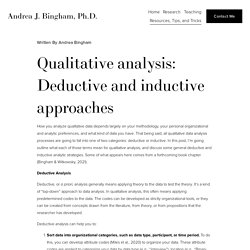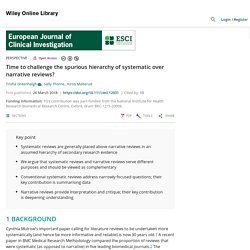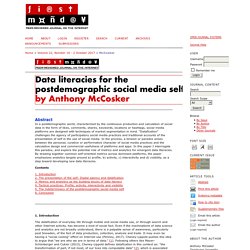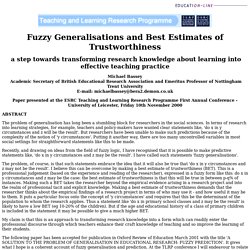

Qualitative analysis: Deductive and inductive approaches — Andrea J. Bingham, Ph.D. How you analyze qualitative data depends largely on your methodology, your personal organizational and analytic preferences, and what kind of data you have.

That being said, all qualitative data analysis processes are going to fall into one of two categories: deductive or inductive. In this post, I’m going outline what each of those terms mean for qualitative analysis, and discuss some general deductive and inductive analytic strategies. Some of what appears here comes from a forthcoming book chapter (Bingham & Witkowsky, 2021). Deductive Analysis Deductive, or a priori, analysis generally means applying theory to the data to test the theory. Indigenous Research Methods: A Reading List. Last week I wrote about challenging the dominance of English in writing for research and academia. That theme is also relevant to this post, though here it’s more about challenging Euro-Western epistemologies and methods than the English language itself. Over the last year I have built a personal library of books about, or relevant to, my investigation of Indigenous research methods and ethics.
The point of this, for me, is to bring these methods into my scholarship, alongside creative and conventional methods, as appropriate. The point is not to become an ‘expert’ on Indigenous research; for a white British person, that is not, should not be, an option. Time to challenge the spurious hierarchy of systematic over narrative reviews? - Greenhalgh - 2018 - European Journal of Clinical Investigation. Key point Systematic reviews are generally placed above narrative reviews in an assumed hierarchy of secondary research evidence We argue that systematic reviews and narrative reviews serve different purposes and should be viewed as complementary Conventional systematic reviews address narrowly focused questions; their key contribution is summarising data Narrative reviews provide interpretation and critique; their key contribution is deepening understanding Cynthia Mulrow's important paper calling for literature reviews to be undertaken more systematically (and hence be more informative and reliable) is now 30 years old.1 A recent paper in BMC Medical Research Methodology compared the proportion of reviews that were systematic (as opposed to narrative) in five leading biomedical journals.2 The authors found significant diversity: from New England Journal of Medicine (0%) and Lancet (11%) to Annals of Internal Medicine (72%).

Data literacies for the postdemographic social media self. In a postdemographic world, characterized by the continuous production and calculation of social data in the form of likes, comments, shares, keywords, locations or hashtags, social media platforms are designed with techniques of market segmentation in mind.

“Datafication” challenges the agency of participatory social media practices and traditional accounts of the presentation of self in the use of social media. In the process, a tension or paradox arises between the personal, curative or performative character of social media practices and the calculative design and commercial usefulness of platforms and apps. In this paper I interrogate this paradox, and explore the potential role of metrics and analytics for emergent data literacies. By drawing together common self-oriented metrics across dominant platforms, the paper emphasizes analytics targets around a) profile, b) activity, c) interactivity and d) visibility, as a step toward developing new data literacies. Contents1. Negativity and anti-social attention seeking among narcissists on Twitter: A linguistic analysis. A linguistic analysis shows differences in the way narcissistic and non-narcissistic users communicate on Twitter.

Because narcissism is marked by attention-seeking, and is related to negativity and perceived victimization, we hypothesized that narcissists would use more words about anger and negative emotions. Conversely, we further hypothesized that they would use fewer words about social interaction and positive emotions. An analysis of over 1,000 users supported these hypotheses. Contents1. Introduction2. A Great Cities Initiative of the University of Illinois at Chicago University Library. Presence, or the sense of being-there and being-with in the new media society.
The public sphere and social capital: Unlikely allies in social media interactions? Fuzzy generalisations and best estimates of trustworthiness: a step towards transforming research knowledge about learning into effective teaching practice. Fuzzy Generalisations and Best Estimates of Trustworthiness a step towards transforming research knowledge about learning into effective teaching practice Michael Bassey Academic Secretary of British Educational Research Association and Emeritus Professor of Nottingham Trent University E-mail: michaelbassey@bera2.demon.co.uk Paper presented at the ESRC Teaching and Learning Research Programme First Annual Conference - University of Leicester, Friday 10th November 2000 The problem of generalisation has long been a stumbling block for researchers in the social sciences.

The Coding Manual for Qualitative Researchers - Johnny Saldana. Effect Sizes, Robust or Bogus? Reflections from my discussions with Hattie and Simpson - ollie lovell. This post is the story of one passionate educator trying to honestly work out whether effect sizes are worth the prominence they currently enjoy in educational research, or whether they’re a complete waste of time.

About six months ago now I came across a paper entitled ‘The misdirection of public policy: Comparing and combining standardised effect sizes’ by Adrian Simpson. In the paper, Adrian wrote about three factors that influence effect sizes, yet have nothing to do with the efficacy of the educational approach being studied. These three factors are: unequal comparison groups, range restriction, and measurement design. Adrian’s paper suggested to me that I had been placing far too much faith in aggregated effect sizes, and I felt a bit of a sinking feeling in my stomach as I thought back to all the times I’d cited them as support for various educational approaches.
I invited Adrian onto the ERRR to explore these ideas in more detail. The Argument: This argument is quite intuitive. Evidence Based Educational Leadership. ANOVA Test: Definition, Types, Examples - Statistics How To. Statistics Definitions > ANOVAContents: The ANOVA Test An ANOVA test is a way to find out if survey or experiment results are significant.

In other words, they help you to figure out if you need to reject the null hypothesis or accept the alternate hypothesis. Basically, you’re testing groups to see if there’s a difference between them. It's the effect size, stupid: what effect size is and why it is important. Time to challenge the spurious hierarchy of systematic over narrative reviews? - Greenhalgh - - European Journal of Clinical Investigation. Robert Cantwell - Google Scholar Citations. Robert Cantwell - Google Scholar Citations.